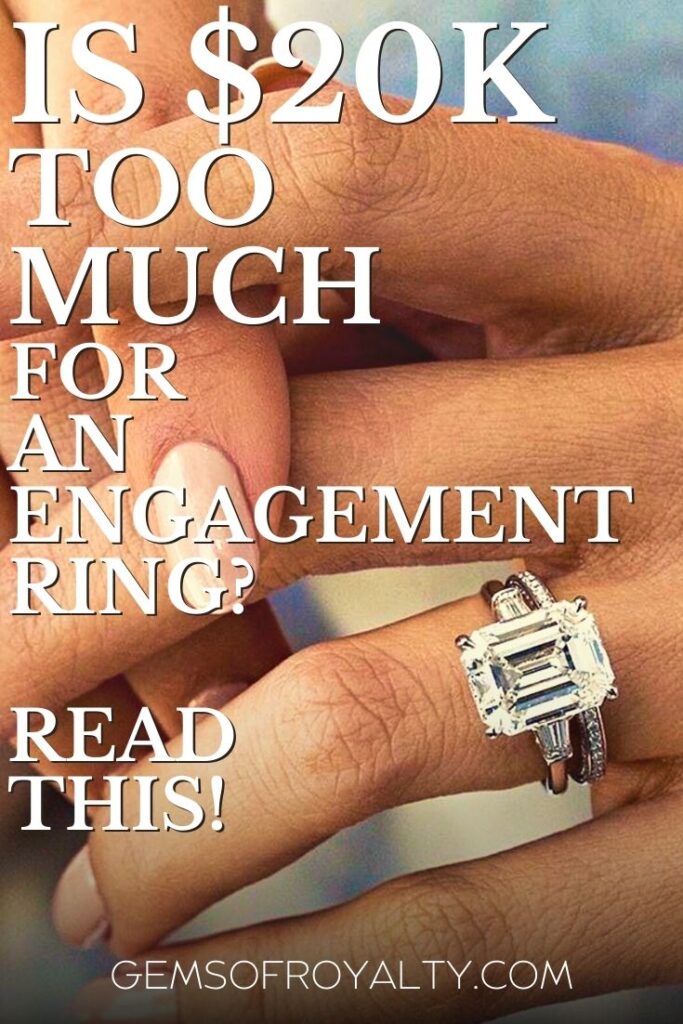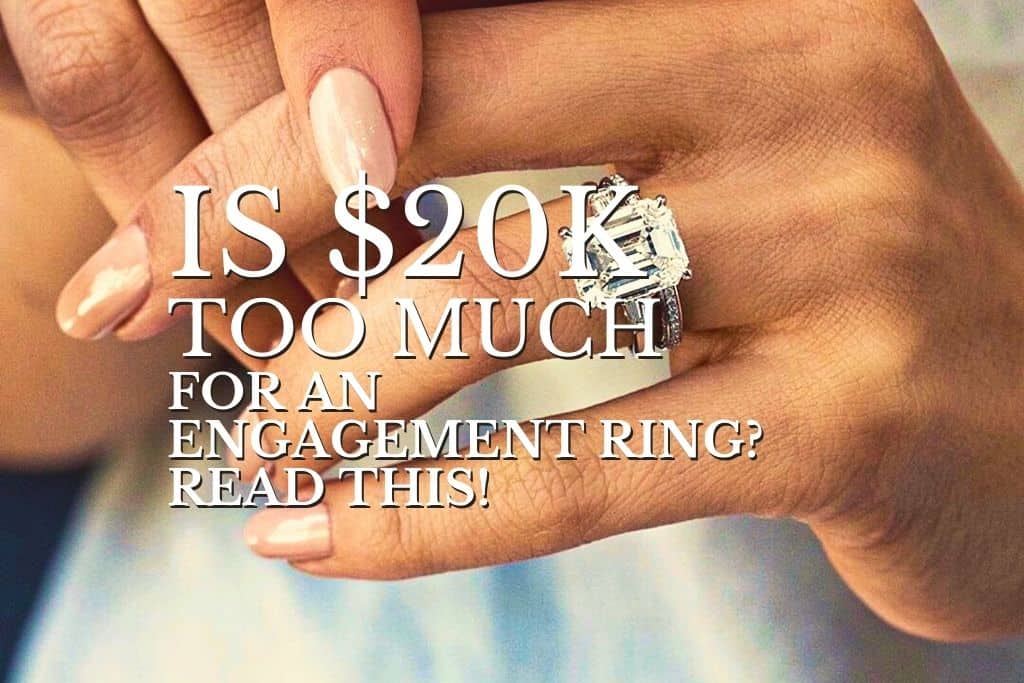Engagement rings are traditionally expensive, with some paying as much as $20k or more for a ring. People pay top dollar for an engagement ring because it’s considered a once-in-a-lifetime purchase worth its hefty price tag. But should there be a price ceiling?
$20k is too much for an engagement ring, especially if it makes a considerable dent in your finances. An engagement ring doesn’t have to be expensive to be valuable, but what truly counts is that the jewelry suits your future spouse’s style and personality.
This article will discuss why you shouldn’t spend too much on an engagement ring and what factors to consider when choosing a ring for your future spouse. We’ll also talk about engagement stone alternatives that won’t make a big dent in your savings, so stick around!
How Much Should You Spend On an Engagement Ring?

You don’t need to spend a lot of money on an engagement ring, but you might want to set aside an amount within your budget to get you what you want. Remember that your future spouse will wear this every day for the rest of their life, so invest in a high-quality ring that will stand the test of time.
Conventional advice states that you should spend three months’ worth of your annual salary on an engagement ring for your future spouse, which was a hard and fast rule in earlier days. But this betrothal ring etiquette is, in fact, based on a 1930s marketing campaign of top diamond retailer De Beers during challenging times for the diamond industry.
You can use the 3-month rule as a general guide but only spend what feels comfortable to you, as you want to avoid going into debt for an engagement ring if you can help it.
After all, you can always upgrade to a better ring when your financial situation improves later.
What Does the Average Engagement Ring Cost?
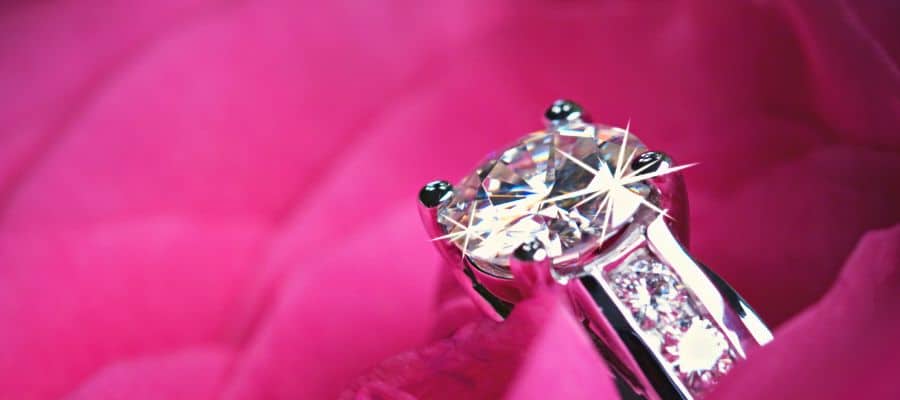
On average, people spend about $6k on an engagement ring. Several factors influence the cost, which can include the following:
- Details
- Craftsmanship
- Quality
- Setting
What Factors Influence Engagement Ring Price?
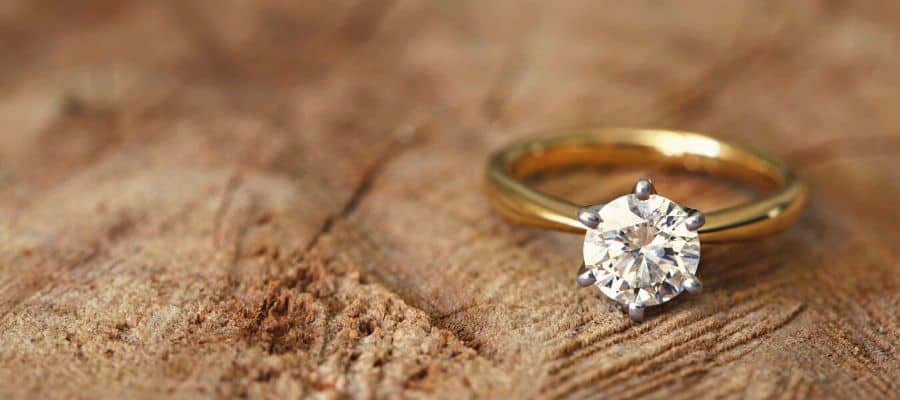
When you add expensive diamonds or choose rare metals for the ring, it’s going to increase the price of your engagement ring. Fortunately, many other stones or beautiful metals may work better for your price range.
The Type of Metal Can Impact the Price
The band or setting used for the ring can drive the price up or down. For instance, platinum costs more than gold because it is denser, so more materials are required to make up the same ring circumference as gold.
Some bands you can buy that’ll save you some money include:
- Stainless steel
- Titanium
- Tungsten
Choosing Celebrity Designers Costs More
A ring with intricate details will cost more than a plain-looking one, as the craftsmanship that goes into the ring increases the cost. You’ll also spend more if you purchase a ring from a well-known designer, like a celebrity or local chain recently receiving rave reviews.
Customizing Your Ring Creates a Higher Cost
Personalizing your ring will increase the price, and many buyers opt to take this route because this adds more sentimental value to the ring. But if you don’t have your name or date engraved, it can save you a lot of money.
You may want to decide how important it is to customize your ring and consider alternatives like having customization done later or buying complimentary jewelry for less.
The Jeweler You Choose Can Drive Up the Price
Buying a ring from a boutique shop may cost more than going with a larger store. The reason for this is that boutique shops put more work, care, and time into the rings they sell. While you can save money by shopping at various jewelry malls or reputable online vendors, you might not find the perfect ring at a big box store.
The Stone You Choose Determines Your Final Price
Diamonds are the traditional choice for engagement rings, and most people think it is well worth the price tag, especially since an engagement ring is a once-in-a-lifetime splurge.
Consider the infamous 4 Cs:
- Carat: This measurement indicates the heaviness of a stone, and the more it weighs, the more expensive it will be.
- Cut: The shape and cut of the diamond matter, as intricate, complex cuts cost more than simpler ones. For instance, a heart-shaped stone will be pricier than a traditional princess cut.
- Color: Generally, colorless diamonds are more expensive than colored or tinted ones. However, unique options, like pink or blue, are rarer and costlier.
- Clarity: A flawless stone is considered rare, so the clearer a diamond is, the more expensive it will be.
Affordable Alternative Engagement Ring Stones
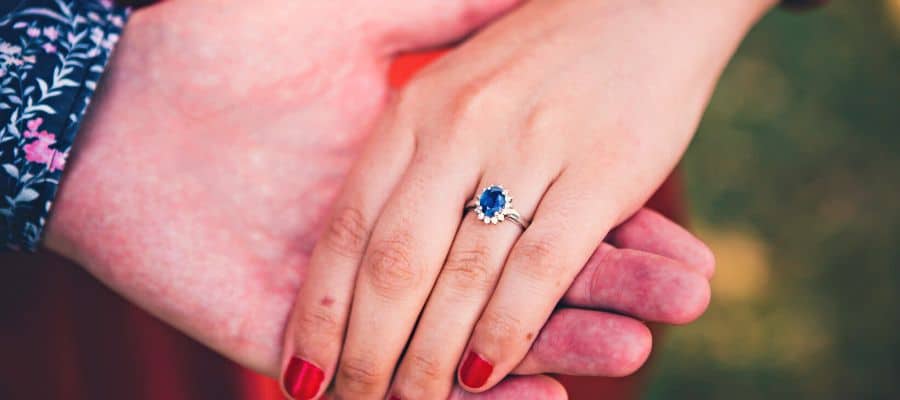
Diamonds are a traditional stone for engagement rings. They are also a solitary diamond in the iconic Tiffany setting that has a timeless elegance that’s still popular after over 100 years.
They are loved for their durability, perfectly encapsulated in the saying, “Diamonds are forever,” and are made of carbon, which makes them highly resistant to some of the issues that commonly affect engagements stones such as chips, scratches, and normal wear and tear.
Diamonds are also versatile and go well with any outfit.
Nonetheless, engagement rings don’t always have to feature diamonds. You can inject your own unique style and personality into your ring by choosing a special and more relevant stone for you and your future spouse.
Choose a Sapphire Engagement Ring
This gemstone typically comes in royal blue, but there are also several other colors. It was the stone of choice with engagement rings in the early 1900s until De Beers launched a marketing campaign that promoted diamond engagement rings.
Sapphires are almost as hardy as diamonds and are thus ideal for everyday wear, so if you’re after quality, look for a stone that’s clear, flawless, and shiny.
An Emerald Ring Might Be Nice
The emerald is one of the rarest gemstones known to symbolize royalty with its rich green color. You might typically find emeralds with natural inclusions since flawless emeralds are extremely hard to find, but they require more care than diamonds since they aren’t as durable and can be prone to scratches and chips.
Try a Diamond Look-Alike Such as Moissanite
This is a great diamond alternative with a significantly lower price range, yet it looks and feels like a diamond. You don’t have to sacrifice aesthetics and durability with this stone because most people can’t tell the difference between this and a diamond anyways.
Cubic Zirconia is Another Diamond Substitute
Lab-made cubic zirconia is a second popular go-to for people looking for a diamond look-alike. Less expensive than diamonds, they offer similar amounts of light dispersion and brilliance, but the shift in price range comes with a few caveats:
- Cubic zirconia is not as durable as diamonds.
- Chipping and scratching can easily occur.
- It’s porous.
- Dulling can happen from absorbing oils.
Glass Can Be a Final Resort Stone Substitute
Glass can be cut and polished to look like gemstones, and they look almost as attractive as diamonds, especially with intricate settings. However, glass breaks easily and can incur scratches and chips from the slightest contact.
Final Thoughts
Engagement rings are a promise to your future spouse that you will love, support, and be loyal to them forever. It’s not surprising that most people splurge lavishly on an engagement ring, spending several months’ salary.
But this once-in-a-lifetime purchase should not diminish your savings account significantly.
Starting your journey as a couple with debt and financial instability is not a good idea, so if $20k feels like too much for your engagement ring, it most likely is. Luckily there are plenty of affordable options for you to consider.
If you found this article useful, make sure you save this pin below to your Wedding/Engagement board.
